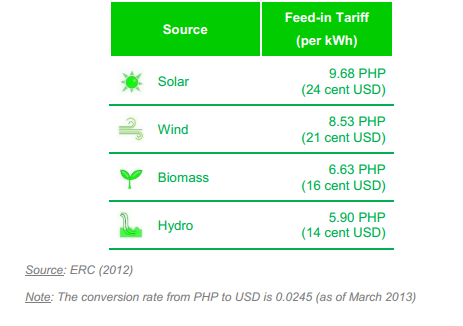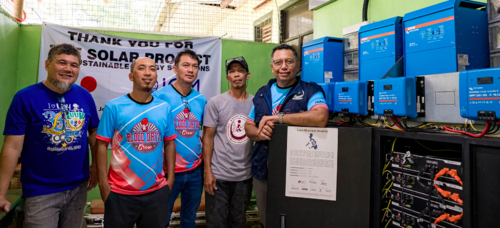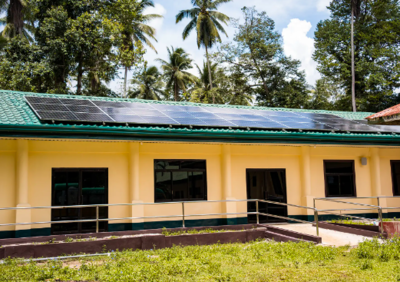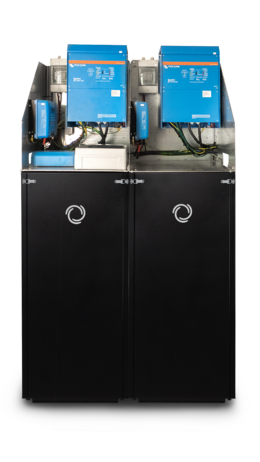Difference between revisions of "Philippines Energy Situation"
***** (***** | *****) (Created page with "{{CES Country |CES Country Name=Philippines |CES Country Capital=Manila |CES Country Region=South Asia |CES Country Coordinates=13.0000° N, 122.0000° E }} [[Category:CES Co...") |
***** (***** | *****) m |
||
| (64 intermediate revisions by 3 users not shown) | |||
| Line 1: | Line 1: | ||
| − | {{CES Country | + | {{CES Country|CES Country Name=Philippines |
| − | |CES Country Name=Philippines | ||
|CES Country Capital=Manila | |CES Country Capital=Manila | ||
| − | |CES Country Region= | + | |CES Country Region East Asia and Pacific=East Asia & Pacific |
|CES Country Coordinates=13.0000° N, 122.0000° E | |CES Country Coordinates=13.0000° N, 122.0000° E | ||
}} | }} | ||
| − | + | = Energy Situation = | |
| − | [[ | + | The Philippines is an emerging economy and its economy has greatly shifted from agriculture to industry.In terms of energy use, conventional fossil fuels (oil and gas) are the main source for its primary energy demands. According to the 2011 primary energy consumption of the Philippines, 31% of the consumption was met by oil, 20% by coal, 22% by geothermal, 12% by biomass, 6% by hydro and 1% by other renewable energy like wind, solar and biofuel. <ref name="ASEAN">http://aseanrenewables.info/wp-content/uploads/2013/07/PH-Philippines_Rev05.pdf </ref> |
| − | [[ | + | |
| − | [[ | + | The Philippines is located in the Pacific Ring of Fire and thus has a high geothermal potential. In terms of electricity generation, 41.4% of the electricity demand is met by geothermal energy, 28% by coal, 11.4% by hydro, 15% by natural gas and 0.1% by wind, solar and biofuel. In terms of installed capacity for power generation Hydro is 63.2%, 35.1% is geothermal , 1.1% is biomass and 0.6% by wind and 0.1% solar. <ref name="ASEAN">http://aseanrenewables.info/wp-content/uploads/2013/07/PH-Philippines_Rev05.pdf </ref> |
| + | |||
| + | = Electricity Situation = | ||
| + | |||
| + | The table below provides an overview of the electricity tariffs in Philippiness<ref name="ASEAN">http://aseanrenewables.info/wp-content/uploads/2013/07/PH-Philippines_Rev05.pdf </ref>: [[File:Electricity Tariff Philippines.PNG|border|684px|Electricity Tariff in Philippines|alt=Electricity Tariff in Philippines]] | ||
| + | |||
| + | = Policy = | ||
| + | |||
| + | The Government of Philippines has introduced various policies to foster renewable energy . Some of the policies are income tax holiday up to 7 years, duty-free import of equipment for renewable energy technologies and so on. In 2012, the government launched the new feed-in tariff (FIT) and is summarized in the table below<ref name="ASEAN">http://aseanrenewables.info/wp-content/uploads/2013/07/PH-Philippines_Rev05.pdf </ref>:<br/>[[File:Energy Policy in Philippines.PNG|border|463px|Feed in Tariff in the Philippines|alt=Feed in Tariff in the Philippines]] | ||
| + | |||
| + | <div class="box box-blue" > | ||
| + | = [[Image:BOS Logo grey.png|100px|right|link=https://www.bos-ag.com/]] Case Studies from BOS ([[Partner and Sponsor Program|Featured Content]]) = | ||
| + | |||
| + | === [https://www.bos-ag.com/luuk-hospital-located-in-sulu-philippines/project/ Energy Situation at Luuk Hospital on Sulu Island] === | ||
| + | |||
| + | The Philippines, with its vast archipelago of more than 7,600 islands, many of which are far from civilization, faces significant energy challenges. Due to their remote location, rural hospitals, such as the Luuk Municipal Hospital in Sulu, often struggle to secure a consistent and affordable supply of clean energy. | ||
| + | |||
| + | The Luuk Hospital's original solution was a diesel generator, which proved to be unsustainable, costly, and unreliable, often failing to meet the hospital's energy needs. Essential medical equipment, including X-ray machines and vital refrigeration equipment for storing blood and vaccines, would often not operate effectively due to the generator's limitations. | ||
| + | |||
| + | Working with a local installer, BOS Balance of Storage Systems AG was able to implement a sustainable energy solution as part of the Renewable Energy Solutions Programme (RES programme) resolving preceding energy problems. This solar island system consists of 55.08 kWp photovoltaic (PV) modules coupled with the BOS system pro, which includes lithium-iron-phosphate batteries with 86.4 kWh storage capacity. | ||
| + | |||
| + | <div class="grid stretch-items"> | ||
| + | <div class="width-1-2"> | ||
| + | <center>[[File:Hospital1.png|500px|link=|frameless]]</center> | ||
| + | <center><small>''The Hospital staff with the installed BOS systems''</small></center> | ||
| + | </div> | ||
| + | <div class="width-1-2"> | ||
| + | <center>[[File:Hospital2.png|400px|link=|frameless]]</center> | ||
| + | <center><small>''The installed solar panels at Luuk Hospital''</small></center> | ||
| + | </div> | ||
| + | </div> | ||
| + | |||
| + | === Improved Electricity Supply for rural Hospitals === | ||
| + | |||
| + | <div class="grid stretch-items"> | ||
| + | <div class="width-2-3"> | ||
| + | [https://www.bos-ag.com/ BOS Balance of Storage Systems AG] has adeptly expanded the Philippines' healthcare energy infrastructure, implementing solar solutions in eight facilities, thereby adding 450 kWh of lithium storage and 220 kWp of photovoltaic capacity. This strategic deployment has resulted in considerable improvement of financial efficiency, with entities such as Luuk Municipal Hospital realizing monthly savings of 50,000 to 100,000 PHP (892 – 1784 USD). | ||
| + | |||
| + | These savings are a direct result of the local utility rate of P12/kWh and a marked decrease in reliance on diesel-generated power. This financial relief enabled the Luuk Hospital to minimize surcharges, making healthcare more affordable for the community. | ||
| + | |||
| + | The implemented [https://www.bos-ag.com/products/bos-system-pro/ BOS system pro] is at the core of these achievements. Its ready-to-deploy configuration has been tailored for challenging environments such as the southern Philippines. Its modular design as well as the installation and maintenance training of the local staff at GoGridless ensure a long-term product lifecycle from a reliable energy solution made for geographically isolated communities. | ||
| + | |||
| + | </div> | ||
| + | <div class="width-1-3"> | ||
| + | <center>[[File:BOS storage.png|260px|link=|frameless]]</center> | ||
| + | <center><small>''BOS system pro enables modular large-scale energy storage''</small></center> | ||
| + | </div> | ||
| + | </div> | ||
| + | ---- | ||
| + | <div class="grid stretch-items"> | ||
| + | <div class="width-1-1"> | ||
| + | <center>[[File:Dena-logos.png|600px|link=|frameless]]</center> | ||
| + | </div> | ||
| + | </div> | ||
| + | ---- | ||
| + | <center>The RES Project Philippines is supported by the German Federal Ministry for Economic Affairs and Climate Action as part of the Renewable Energy Solutions Programme of the German Energy Solutions Initiative.</center> | ||
| + | </div> <!-- End blue box --> | ||
| + | |||
| + | = Further Information = | ||
| + | |||
| + | *[http://www.irena.org/DocumentDownloads/Publications/IRENA_RRA_Philippines_2017.pdf IRENA Renewables Readiness Assessment (RRA) (2017):]Like many countries in South East Asia, the Philippines faces twin challenges of population growth and rising energy demand. Dependent on imports for nearly half its primary energy supply, the country is highly exposed to oil price volatility. Frequent tropical storms, meanwhile, adversely impact its energy infrastructure. In response, the Philippines has resolved to bolster energy security, pursue low-carbon economic development and contribute global efforts against climate change. Renewable energy technologies have become increasingly prominent in national planning and policy-making. An ambitious target adopted in 2011 calls for 15.3 gigawatts of renewable power capacity by 2030. This RRA, undertaken in co-operation with the Philippine government, identifies barriers and proposes key actions to strengthen the policy, regulatory and institutional framework in order to accelerate renewable energy deployment. | ||
| + | |||
| + | = Reference = | ||
| + | |||
| + | <references /> | ||
Latest revision as of 10:45, 17 April 2024
Capital:
Manila
Region:
Coordinates:
13.0000° N, 122.0000° E
Total Area (km²): It includes a country's total area, including areas under inland bodies of water and some coastal waterways.
300,000
Population: It is based on the de facto definition of population, which counts all residents regardless of legal status or citizenship--except for refugees not permanently settled in the country of asylum, who are generally considered part of the population of their country of origin.
115,559,009 (2022)
Rural Population (% of total population): It refers to people living in rural areas as defined by national statistical offices. It is calculated as the difference between total population and urban population.
52 (2022)
GDP (current US$): It is the sum of gross value added by all resident producers in the economy plus any product taxes and minus any subsidies not included in the value of the products. It is calculated without making deductions for depreciation of fabricated assets or for depletion and degradation of natural resources.
404,284,326,110 (2022)
GDP Per Capita (current US$): It is gross domestic product divided by midyear population
3,498.51 (2022)
Access to Electricity (% of population): It is the percentage of population with access to electricity.
97.49 (2021)
Energy Imports Net (% of energy use): It is estimated as energy use less production, both measured in oil equivalents. A negative value indicates that the country is a net exporter. Energy use refers to use of primary energy before transformation to other end-use fuels, which is equal to indigenous production plus imports and stock changes, minus exports and fuels supplied to ships and aircraft engaged in international transport.
45.77 (2014)
Fossil Fuel Energy Consumption (% of total): It comprises coal, oil, petroleum, and natural gas products.
62.43 (2014)
Energy Situation
The Philippines is an emerging economy and its economy has greatly shifted from agriculture to industry.In terms of energy use, conventional fossil fuels (oil and gas) are the main source for its primary energy demands. According to the 2011 primary energy consumption of the Philippines, 31% of the consumption was met by oil, 20% by coal, 22% by geothermal, 12% by biomass, 6% by hydro and 1% by other renewable energy like wind, solar and biofuel. [1]
The Philippines is located in the Pacific Ring of Fire and thus has a high geothermal potential. In terms of electricity generation, 41.4% of the electricity demand is met by geothermal energy, 28% by coal, 11.4% by hydro, 15% by natural gas and 0.1% by wind, solar and biofuel. In terms of installed capacity for power generation Hydro is 63.2%, 35.1% is geothermal , 1.1% is biomass and 0.6% by wind and 0.1% solar. [1]
Electricity Situation
The table below provides an overview of the electricity tariffs in Philippiness[1]: 
Policy
The Government of Philippines has introduced various policies to foster renewable energy . Some of the policies are income tax holiday up to 7 years, duty-free import of equipment for renewable energy technologies and so on. In 2012, the government launched the new feed-in tariff (FIT) and is summarized in the table below[1]:
Case Studies from BOS (Featured Content)
Energy Situation at Luuk Hospital on Sulu Island
The Philippines, with its vast archipelago of more than 7,600 islands, many of which are far from civilization, faces significant energy challenges. Due to their remote location, rural hospitals, such as the Luuk Municipal Hospital in Sulu, often struggle to secure a consistent and affordable supply of clean energy.
The Luuk Hospital's original solution was a diesel generator, which proved to be unsustainable, costly, and unreliable, often failing to meet the hospital's energy needs. Essential medical equipment, including X-ray machines and vital refrigeration equipment for storing blood and vaccines, would often not operate effectively due to the generator's limitations.
Working with a local installer, BOS Balance of Storage Systems AG was able to implement a sustainable energy solution as part of the Renewable Energy Solutions Programme (RES programme) resolving preceding energy problems. This solar island system consists of 55.08 kWp photovoltaic (PV) modules coupled with the BOS system pro, which includes lithium-iron-phosphate batteries with 86.4 kWh storage capacity.


Improved Electricity Supply for rural Hospitals
BOS Balance of Storage Systems AG has adeptly expanded the Philippines' healthcare energy infrastructure, implementing solar solutions in eight facilities, thereby adding 450 kWh of lithium storage and 220 kWp of photovoltaic capacity. This strategic deployment has resulted in considerable improvement of financial efficiency, with entities such as Luuk Municipal Hospital realizing monthly savings of 50,000 to 100,000 PHP (892 – 1784 USD).
These savings are a direct result of the local utility rate of P12/kWh and a marked decrease in reliance on diesel-generated power. This financial relief enabled the Luuk Hospital to minimize surcharges, making healthcare more affordable for the community.
The implemented BOS system pro is at the core of these achievements. Its ready-to-deploy configuration has been tailored for challenging environments such as the southern Philippines. Its modular design as well as the installation and maintenance training of the local staff at GoGridless ensure a long-term product lifecycle from a reliable energy solution made for geographically isolated communities.


Further Information
- IRENA Renewables Readiness Assessment (RRA) (2017):Like many countries in South East Asia, the Philippines faces twin challenges of population growth and rising energy demand. Dependent on imports for nearly half its primary energy supply, the country is highly exposed to oil price volatility. Frequent tropical storms, meanwhile, adversely impact its energy infrastructure. In response, the Philippines has resolved to bolster energy security, pursue low-carbon economic development and contribute global efforts against climate change. Renewable energy technologies have become increasingly prominent in national planning and policy-making. An ambitious target adopted in 2011 calls for 15.3 gigawatts of renewable power capacity by 2030. This RRA, undertaken in co-operation with the Philippine government, identifies barriers and proposes key actions to strengthen the policy, regulatory and institutional framework in order to accelerate renewable energy deployment.





















